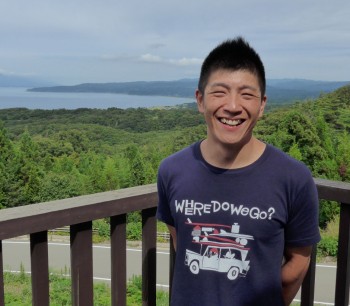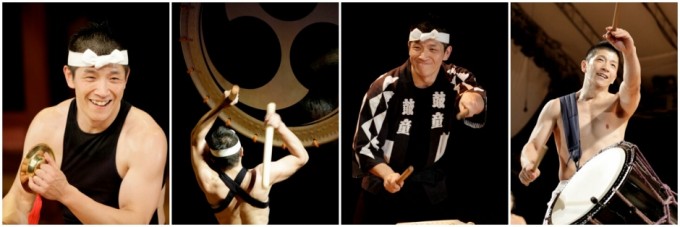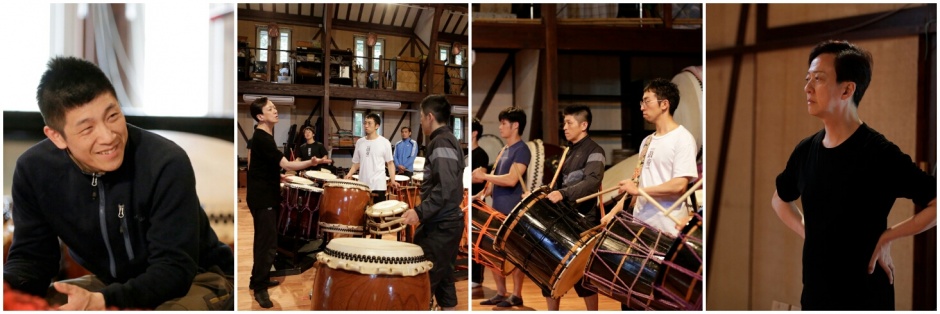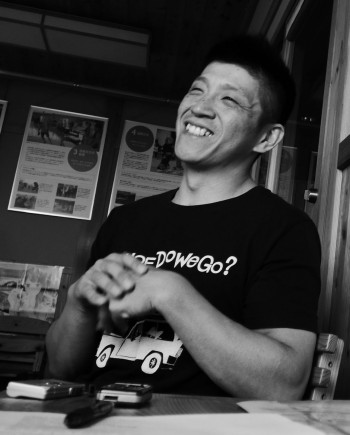Yuichiro Funabashi: An Interview by Johnny Wales
Interview with Yuichiro Funabashi by Johnny Wales

Yuichiro Funabashi (Photo: Johnny Wales)
Yuichiro Funabashi was born on May 9th, 1974 in Kanagawa Prefecture near Tokyo. He grew up in suburban Ninomiya. His father was a salary man and his mother worked in a hospital. He had one sister, 6 years older. He remembers his childhood fondly, describing himself as a life–of–the–party type playing soccer and baseball outside every day. Spinning tops were all the rage, (to put things in historical context) so there was plenty of that too. This was the very tail-end of the baby boom so there were children everywhere, 1,000 students alone in his elementary school, so there was no lack of friends to play with.
In middle school he joined the volleyball club. This became the centre of his world, 7 days a week, until he entered high school. Though his high school was nearby, it had even more students and he felt adrift among all the strange faces. Apart from dabbling in two wildly-divergent interests, American football and the tea ceremony, and some part-time work on archeological digs, he more or less coasted through 3 very dark years. In spite himself though, he did manage to get good enough marks to consider university. He was accepted into the Kyoto University of Art and Design where he studied archeology and artifact conservation. He enjoyed going on digs and he also became interested in marine archeology. It was while preparing for his scuba diving license that his life came to one of those great crossroads. Taiko entered his life.
One day a friend invited him to a meeting of the newly-minted university taiko club. About 10 men and women began to meet several times a week. Eventually they made happi coats with their group’s name on it, Wadaiko Shin. They were taught by local Kyoto taikoists and eventually became at least good enough to appear at local events over the next four years. In Yuichiro’s words, ‘What we lacked in technique we made up for in enthusiasm’.
One day in his sophomore year he went to a Kodo concert. ‘What is this!?’ he found himself thinking. They looked and sounded completely unlike Wadaiko Shin. Their style was simple, straight and stripped-down. He began to consider the idea of turning pro and joining Kodo after graduation.
It wasn’t a complete leap into the dark as he had visited Sado for the 10th anniversary Earth Celebration. Kodo and Sado looked like great fun. Mind you, that was in August. Having decided to apply for a position as an apprentice, his next visit was on a slightly less balmy January day, during a blizzard over storm-tossed seas. It was the first time he ever remembers hearing and seeing thunder and lightning in the winter. He obviously made a good impression because he was accepted into the programme and (after assuring his parents that Kodo wasn’t a religious cult) he moved to Sado with their blessings.
He looks back on the next 2 years of his apprenticeship as a life-altering experience. Though the regimen and lifestyle were pretty severe it never occurred to him to quit. One of the hardest things was being separated from his girlfriend (now wife), far away in Kyoto.
It was the 2nd year of the Apprentice Centre being located in Kakinoura on Sado’s eastern coast. He will never forget the first time some of the senior players came to the school and he heard them playing close-up. He realized that he couldn’t possibly produce that sound so completely different from his, not just the volume, but the quality too. At that moment he decided to forget everything he knew about taiko and start from zero.
He can’t describe how he has since learned how to make the Kodo sound, except to say through practice. Lots of practice. He thinks the greatest difference between his taiko playing as an amateur and now is in the quality of each individual beat on the drum. The intention behind each strike of the drumhead, the quality of it. He suggests that some amateurs don’t think about the sound of each single beat, but rather of the piece as a whole.
Apart from practice, the apprentices were kept busy with a variety of activities, farming, tea ceremony, kyogen drama, and various local crafts. So much so that he almost wished he could have spent even more time on the drums.
After his second year as an apprentice – and the first year of the new millennium – he was accepted into the group. Together with the other successful apprentices he set right off as a probationary Kodo member with the Spring School Workshop Performance tour in Japan. To this day, he feels an especially intense bond with those people he spent those life-changing two years overlooking the stormy Sea of Japan. The ensuing fourteen years have found him featured on taiko, song and dance. He has also directed several Earth Celebration performances.

Yuichiro is now deeply involved in the newest production for One Earth Tour, entitled Eternity. Though he performed under Tamasaburo Bando‘s direction in Amaterasu, his participation on school tours precluded his appearance in both Legend and Mystery.
Legend was based on what Kodo has been doing all along, mixed with newer works. Mystery contained traditional Japanese artistic motifs, for instance a serpent dance was prominently featured. With Eternity everything is new. Each piece has been especially composed for this production. At the beginning of its development a year ago Tamasaburo wrote down things for the contributors to keep in mind as they came up with ideas and compositions for the performance. He wrote about things like ‘the seasons’, ‘the morning sun’ and so on. Then people went off and created pieces that they presented to Tamasaburo. Eternity began to take shape using the ideas he liked best.

Tamasaburo often talks about the importance of small sounds. He likes the pace and intensity to increase and then lessen, to return to the beginning and carry on once more; just like life, just like time itself, in a great circulating wheel. Yuichiro wasn’t at sure at first, but he says that now the players are starting to sense the feeling of eternity. Where Kodo’s performances have traditionally been an assemblage of individual pieces woven into a finished show, Tamasaburo sees the performance as a single creation. Where previously each single composition might encompass a whole range of emotions from quiet, right up to a crashing climax, with Tamasaburo each number is part of the larger picture. One particular piece might only develop so far, and then stay there, without going on to the big finish. The next piece might then go further. The players find themselves having to exercise great restraint, to keep their emotions in check for a particular number, and wait till the next one to take it beyond. Yuichiro considers it a real challenge but says it feels emancipating, too. He hopes that long-time Kodo fans will understand that the Kodo ensemble is challenging itself, exploring whole new worlds for the taiko. Though Yuichiro was happy to repeat the traditional Kodo repertoire, he also yearns to develop. He has discovered the joy in setting off in new directions. Naturally there is an element of fear involved. With only a month or two to go the show is very much unfinished. Tamasaburo says ‘Relax, it’ll be fine!’ but the music is very challenging technically, and everything has to be learned from scratch. Yuichiro admits to the jitters.

Yuichiro during his interview (Photo: Johnny Wales)
He is aware that he has become one of the most senior players appearing regularly on stage. As a central figure in the group he is keenly aware of his responsibility to see that things get done. How can he help make this group even better, more enjoyable to be in and to watch, how can each individual member fulfill their potential? At the age of 40 Yuichiro feels a responsibility to serve as a link between the young players and the veterans that preceded him, between Kodo’s great traditions and an unknown and exciting future.
“Kodo One Earth Tour 2014: Eternity” premieres on Sado Island on November 20.
Photos: Takashi Okamoto



